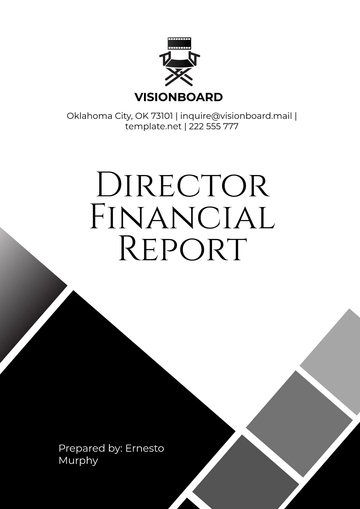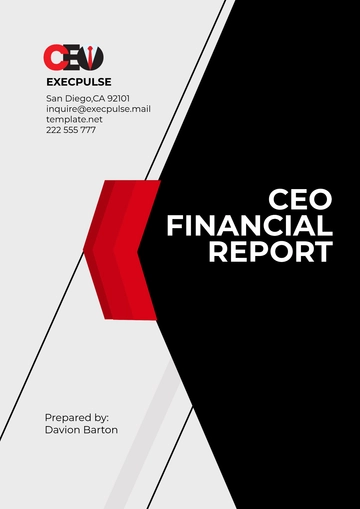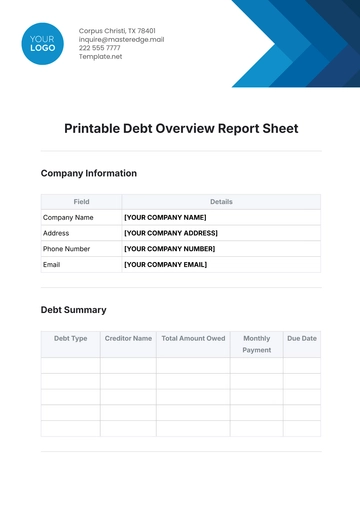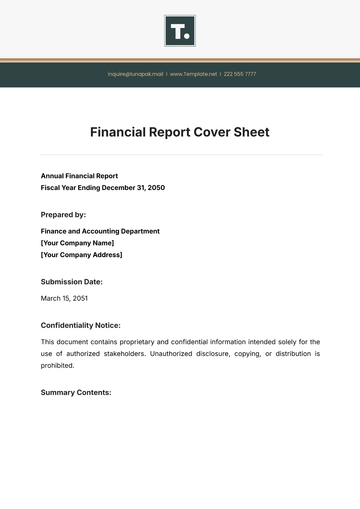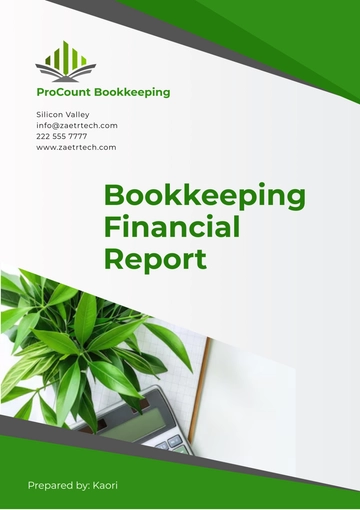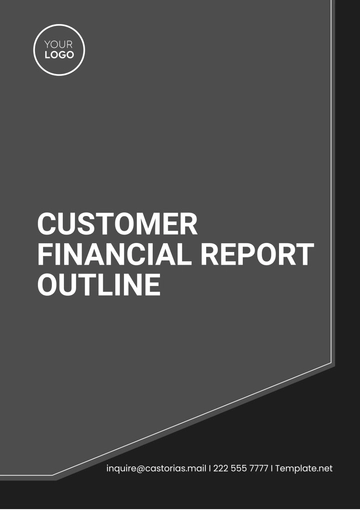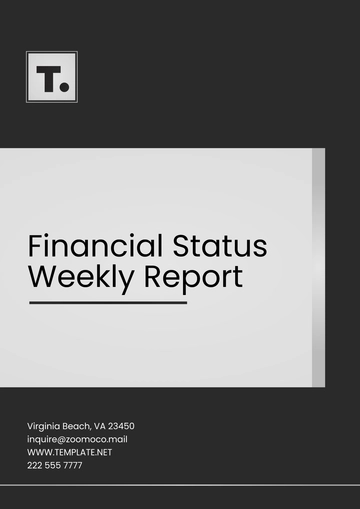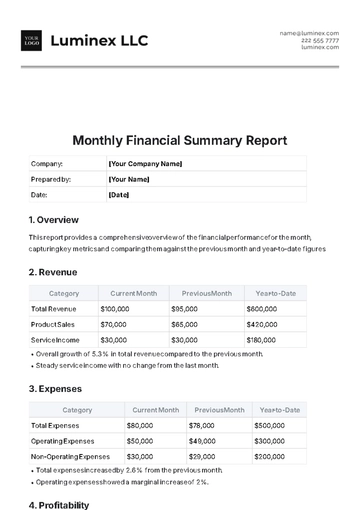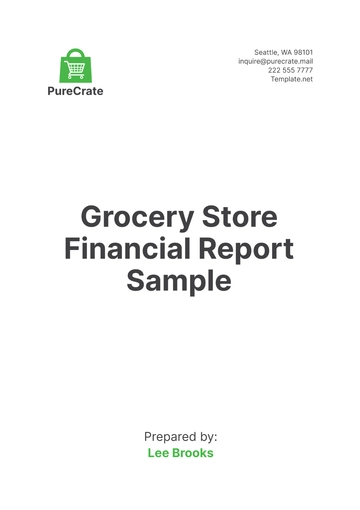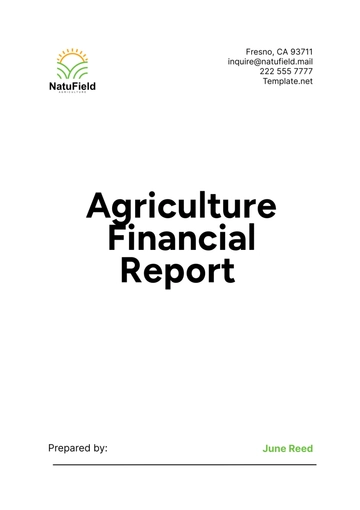Free Financial Reporting Protocol
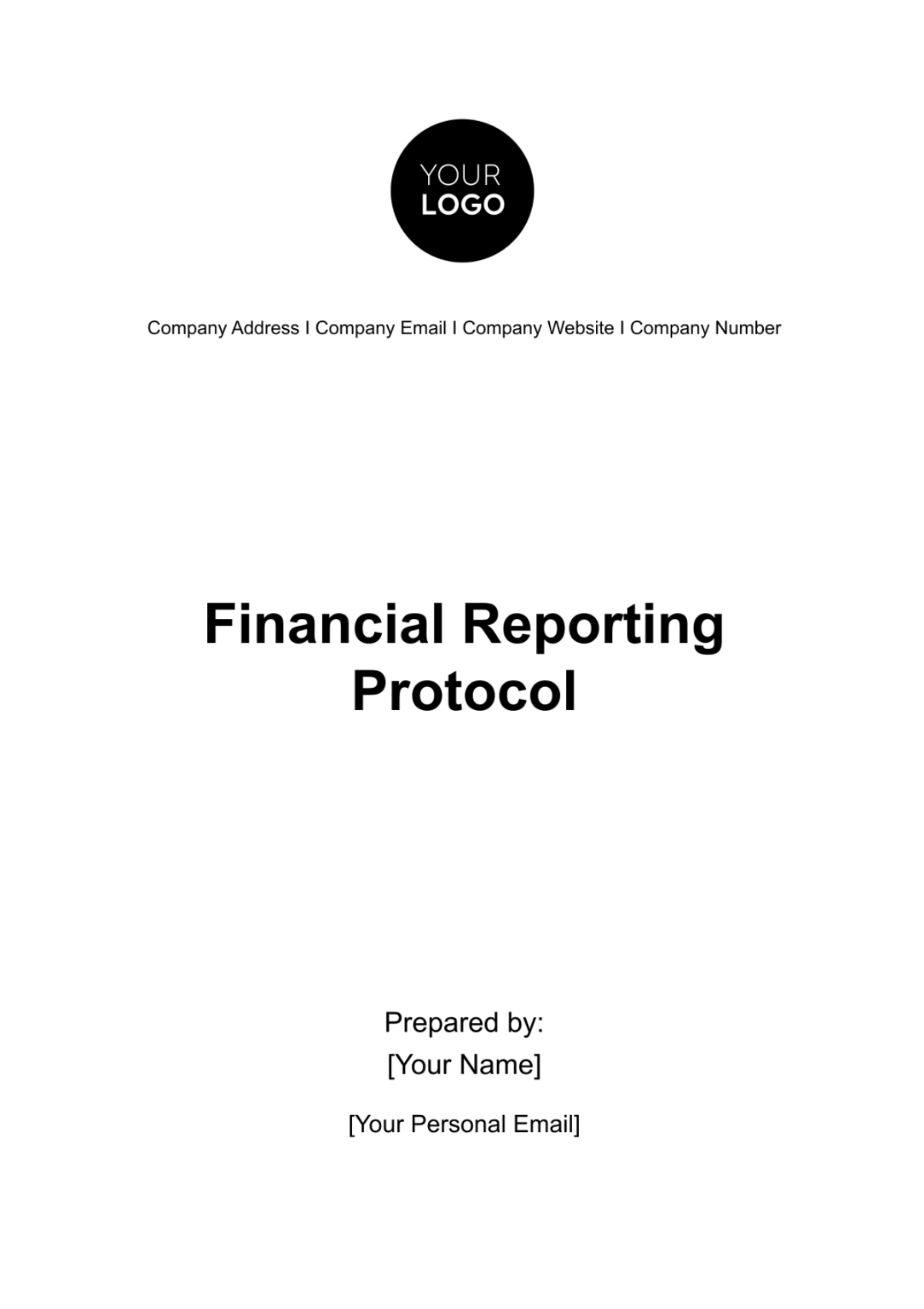
Introduction
A. Background
The Financial Reporting Protocol is established by [Your Company Name] to address the growing need for transparent and standardized financial reporting. Arising from [Your Company Name]'s history of financial excellence, this protocol is crafted to provide a historical context while adapting to the evolving landscape of financial reporting standards.
B. Purpose
The purpose of this protocol goes beyond fulfilling regulatory requirements; it is a strategic initiative by [Your Company Name] to instill confidence among stakeholders. The protocol is designed to be a living document, reflecting the commitment to transparency, integrity, and continuous improvement in financial reporting practices.
C. Objectives
The objectives of the Financial Reporting Protocol are as follows:
Clear Communication: To facilitate clear and concise communication of financial information, ensuring that stakeholders can easily comprehend the financial health of [Your Company Name].
Consistency: To promote consistency and comparability across different reporting periods, allowing stakeholders to make informed decisions based on reliable historical data.
Quality and Reliability: To enhance the overall quality and reliability of financial reporting, setting the standard for accuracy and completeness.
Strategic Decision Support: To provide a foundation for strategic financial planning and analysis, aiding in the formulation and execution of effective business strategies.
Scope
A. Inclusions
The Financial Reporting Protocol encompasses a comprehensive set of financial elements, ensuring a holistic representation of [Your Company Name]'s financial performance:
Revenue: All sources of income generated by [Your Company Name], including sales, services, and other income streams.
Expenses: All costs and expenditures incurred during the reporting period, covering operational, administrative, and financial costs.
Assets: Resources owned or controlled by [Your Company Name], such as cash, accounts receivable, inventory, and tangible assets.
Liabilities: Obligations and debts owed by [Your Company Name], including loans, payables, and other financial obligations.
B. Exclusions
To maintain clarity and focus, this protocol explicitly excludes the following financial elements:
Non-Operational Items: Non-recurring or extraordinary items that may distort the understanding of ongoing operational performance.
Non-Financial Metrics: Metrics not directly related to financial performance, such as customer satisfaction scores or employee engagement metrics.
C. Regulatory Compliance
[Your Company Name] is committed to adhering to all relevant financial regulations and accounting standards. This protocol is designed to ensure compliance with industry-specific regulations and international accounting standards like IFRS or GAAP.
Key Definitions
A. Revenue
Revenue refers to the total income generated by [Your Company Name] through its primary business activities. This includes income from product sales, service provision, and any other sources contributing to the company's top line. The calculation of revenue should encompass all streams and be consistent with recognized accounting standards.
B. EBITDA
EBITDA stands for Earnings Before Interest, Taxes, Depreciation, and Amortization. It is a key financial metric that provides insight into [Your Company Name]'s operational profitability by excluding non-operating expenses. The formula for EBITDA is:
EBITDA = Net Income + Interest + Taxes + Depreciation + Amortization
C. Net Income
Net Income represents the total profit earned by [Your Company Name] after deducting all operating expenses, interest, taxes, and other associated costs. It is a crucial indicator of the company's overall financial performance and is calculated using the formula:
Net Income = Revenue − Expenses − Taxes
Reporting Entities
A. [Your Company Name]
The reporting entity, [Your Company Name], is responsible for adhering to the Financial Reporting Protocol. The financial reporting team within [Your Company Name] plays a pivotal role in ensuring the accuracy and reliability of financial information.
B. Financial Reporting Team
The Financial Reporting Team consists of experienced professionals dedicated to maintaining the highest standards in financial reporting. Roles within the team include:
Chief Financial Officer (CFO): Responsible for overseeing the entire financial reporting process and ensuring compliance with relevant regulations.
Financial Controller: Manages day-to-day financial operations, including the preparation and verification of financial statements.
Accounting Team: Comprising skilled accountants responsible for recording financial transactions accurately.
Reporting Period
A. [January 1, 2050], to [December 31, 2050]
The chosen period of [January 1, 2050], to [December 31, 2050], provides a comprehensive annual overview of [Your Company Name]'s financial performance.
B. Reporting Frequency
Reporting Frequency: Annual
The Financial Reporting Protocol of [Your Company Name] follows an annual reporting frequency. This means that stakeholders can expect detailed financial reports once a year. This aligns with standard business practices and regulatory requirements, allowing stakeholders to gain a thorough understanding of the company's financial health on a yearly basis.
C. Interim Reporting
Interim financial reports will be prepared and communicated in the event of significant business changes, mergers, acquisitions, or other material events affecting financial performance. [Your Company Name] recognizes the importance of providing timely and relevant financial information during crucial business events. Interim reporting ensures that stakeholders are well-informed about any developments that might impact the company's financial status between the regular annual reporting periods.
In specific situations such as:
Significant Business Changes: [Your Company Name] commits to providing interim financial reports if there are substantial changes in the business landscape, such as entering new markets, discontinuing major product lines, or significant shifts in the company's strategic direction.
Mergers and Acquisitions: In the event of mergers, acquisitions, or divestitures, interim financial reports will be promptly prepared to reflect the impact on [Your Company Name]'s financial position and performance.
Other Material Events: Any other material events with a significant impact on financial performance, like major legal proceedings or changes in accounting policies, will trigger the preparation and communication of interim financial reports.
Financial Statements
A. Balance Sheet
Balance Sheet as of [December 31, 2050]
Assets | Amount |
|---|---|
Cash and Equivalents | [$2,500,000] |
B. Liabilities and Equity
Liabilities | Amount |
|---|---|
Accounts Payable | [$1,500,000] |
Equity | Amount |
|---|---|
Share Capital | [$4,000,000] |
C. Income Statement
Income Statement for the Year Ended [December 31, 2050]
Revenue Streams | Amount |
|---|---|
Sales | [$20,000,000] |
D. Operating Expenses
Expense Categories | Amount |
|---|---|
Cost of Goods Sold | [$9,000,000] |
E. Cash Flow Statement
Cash Flow Statement for the Year Ended [December 31, 2050]
Cash Flow Activities | Amount |
|---|---|
Operating Activities | [$8,000,000] |
Financial Health Metrics
A. Liquidity Ratios
Liquidity ratios are critical indicators of [Your Company Name]'s ability to meet short-term financial obligations. They assess the company's liquidity and its capacity to cover immediate financial needs. The following liquidity ratios will be analyzed and included in the financial reports:
Net Cash Flow ratio of current assets to current liabilities. A current ratio above 1 indicates that [Your Company Name] has more assets than liabilities, suggesting a healthy short-term financial position.
Current Ratio = Current Assets / Current Liabilities
Current Ratio= Current Liabilities / Current Assets
Quick Ratio: Also known as the acid-test ratio, it measures the ability to meet short-term obligations without relying on the sale of inventory.
Quick Ratio = Current Assets - Inventory / Current Liabilities
Quick Ratio= Current Liabilities / Current Assets - Inventory
B. Debt-to-Equity Ratio
The debt-to-equity ratio is a key metric indicating [Your Company Name]'s leverage and financial risk. It compares the company's total debt to its shareholders' equity.
Debt-to-Equity Ratio = Total Debt / Shareholders’ Equity
Debt-to-Equity Ratio= Shareholders’ Equity / Total Debt
Risk Management Strategies
A. Identification and Assessment
[Your Company Name] recognizes the importance of proactive risk management to safeguard its financial health. This section outlines the strategies for identifying and assessing various risks, including market risk, operational risk, and regulatory compliance risk.
Regular Risk Assessments: [Your Company Name] will conduct regular risk assessments to identify and evaluate potential risks to financial stability. This involves a comprehensive analysis of market conditions, operational processes, and compliance with industry regulations.
Scenario Analysis: The company will perform scenario analysis to model the potential impact of various adverse events on its financial position. This helps in developing contingency plans to mitigate identified risks.
B. Mitigation and Monitoring
After identifying and assessing risks, [Your Company Name] will implement strategies for risk mitigation and continuous monitoring.
Diversification: Diversifying revenue streams and investments to reduce dependency on a single source and minimize market-related risks.
Robust Compliance Measures: Ensuring strict adherence to regulatory requirements and industry standards to mitigate compliance risks.
Monitoring Key Indicators: Regular monitoring of key financial health indicators and implementing prompt corrective actions in case of deviations.
- 100% Customizable, free editor
- Access 1 Million+ Templates, photo’s & graphics
- Download or share as a template
- Click and replace photos, graphics, text, backgrounds
- Resize, crop, AI write & more
- Access advanced editor
Optimize financial reporting protocols with the Financial Reporting Protocol Template on Template.net. This editable and customizable template simplifies the protocol creation process. Tailor content effortlessly using our Ai Editor Tool, ensuring adaptability and precision. Elevate your financial documentation with this user-friendly template, offering a comprehensive approach to crafting personalized reporting protocols for effective and streamlined financial communication.
You may also like
- Sales Report
- Daily Report
- Project Report
- Business Report
- Weekly Report
- Incident Report
- Annual Report
- Report Layout
- Report Design
- Progress Report
- Marketing Report
- Company Report
- Monthly Report
- Audit Report
- Status Report
- School Report
- Reports Hr
- Management Report
- Project Status Report
- Handover Report
- Health And Safety Report
- Restaurant Report
- Construction Report
- Research Report
- Evaluation Report
- Investigation Report
- Employee Report
- Advertising Report
- Weekly Status Report
- Project Management Report
- Finance Report
- Service Report
- Technical Report
- Meeting Report
- Quarterly Report
- Inspection Report
- Medical Report
- Test Report
- Summary Report
- Inventory Report
- Valuation Report
- Operations Report
- Payroll Report
- Training Report
- Job Report
- Case Report
- Performance Report
- Board Report
- Internal Audit Report
- Student Report
- Monthly Management Report
- Small Business Report
- Accident Report
- Call Center Report
- Activity Report
- IT and Software Report
- Internship Report
- Visit Report
- Product Report
- Book Report
- Property Report
- Recruitment Report
- University Report
- Event Report
- SEO Report
- Conference Report
- Narrative Report
- Nursing Home Report
- Preschool Report
- Call Report
- Customer Report
- Employee Incident Report
- Accomplishment Report
- Social Media Report
- Work From Home Report
- Security Report
- Damage Report
- Quality Report
- Internal Report
- Nurse Report
- Real Estate Report
- Hotel Report
- Equipment Report
- Credit Report
- Field Report
- Non Profit Report
- Maintenance Report
- News Report
- Survey Report
- Executive Report
- Law Firm Report
- Advertising Agency Report
- Interior Design Report
- Travel Agency Report
- Stock Report
- Salon Report
- Bug Report
- Workplace Report
- Action Report
- Investor Report
- Cleaning Services Report
- Consulting Report
- Freelancer Report
- Site Visit Report
- Trip Report
- Classroom Observation Report
- Vehicle Report
- Final Report
- Software Report



